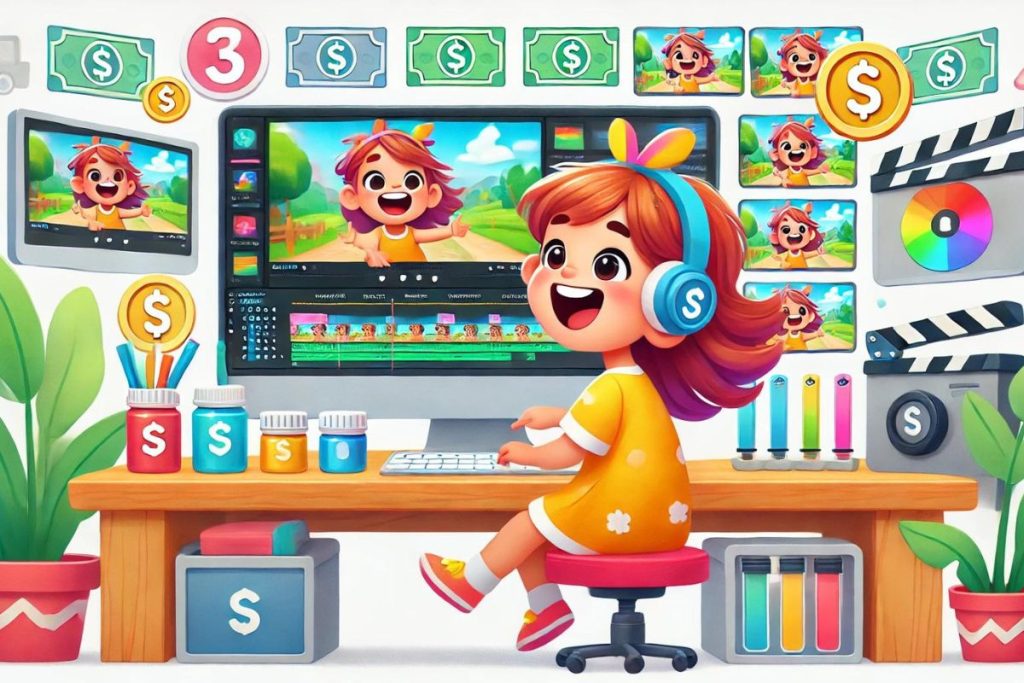Are you captivated by the magic of video storytelling? Do you find yourself analyzing every cut, transition, and effect in your favorite movies or YouTube videos? If so, a career in video editing may well be your perfect calling.
In today’s digital age, the demand for skilled video editors is skyrocketing. From social media content to Hollywood blockbusters, video editors play a crucial role in shaping the visual narratives that captivate audiences worldwide. But how do you break into this exciting field? What skills do you need, and where do you start?
In this guide, we’ll walk you through the steps to become a successful video editor. You’ll learn about the essential skills, software, and techniques that’ll set you on the path to turning your passion for video into a rewarding career. Whether you’re a complete beginner or looking to enhance your existing skills, we’ve got you covered.
What Is Video Editing?
Video editing combines and rearranges video shots to create a cohesive visual story. It’s a post-production process for films, TV shows, ads, and video essays. Editors use techniques like cutting segments, re-sequencing clips, and adding transitions to craft the final product.
There are two main types of video editing: linear and non-linear. Linear editing uses video tape and arranges clips sequentially. Non-linear editing (NLE) happens on computers with specialized software, allowing for non-destructive edits to raw footage.
Popular NLE software includes DaVinci Resolve, Avid Media Composer, Adobe Premiere Pro, and Final Cut Pro. These programs give you the tools to transform raw footage into polished, professional-looking videos.

Skills Required for Video Editing
Video editing demands a blend of technical expertise and creative flair. To excel in this field, you’ll need to master specific skills in both areas.
Technical Skills
Proficiency in industry-standard software like Adobe Premiere Pro or Final Cut Pro is crucial. You must understand video formats, codecs, and compression techniques. Audio-video synchronization skills are essential, as is the ability to perform color correction and grading. Familiarity with special effects and motion graphics software enhances your versatility.
Creative Skills
Strong storytelling abilities help you craft compelling narratives through visual elements. A keen eye for detail allows you to make precise cuts and transitions. Understanding pacing and rhythm is vital for maintaining viewer engagement. Creativity in problem-solving helps you overcome technical challenges. Collaboration skills are important when working with directors, producers, and other team members.
Education and Training Options
Video editing careers require a mix of formal education and practical skills. Here’s how you can prepare for this field:
Formal Education
Pursue a bachelor’s degree in film and video production, cinematography, or communication. These programs offer comprehensive training in videography, editing techniques, and camera operation. Film schools provide hands-on experience with industry-standard equipment and software.
Online Courses and Certifications
Enhance your skills with online courses and certifications. Software manufacturers like Adobe offer certifications that demonstrate technical proficiency. Certificate programs in Premiere Pro, After Effects, and Photoshop prove your expertise to potential employers.
Essential Software and Tools
Video editing requires specific software and hardware to create professional-quality content. Here’s what you’ll need:
Video Editing Software
Adobe Premiere Pro offers powerful editing tools and organization systems. Final Cut Pro includes features like proxy files and auto-cropping for social media. DaVinci Resolve provides detailed audio and video features for professional tutorials. After Effects allows for animation and special effects insertion. Audition is used for audio editing and podcast recording.
Hardware Requirements
A high-performance computer with ample RAM and processing power is crucial for smooth editing. Graphics cards with dedicated memory enhance rendering speeds. Multiple monitors increase workspace efficiency. External hard drives or network-attached storage provide extra space for large video files. A quality mouse or tablet improves precision in editing tasks.
Building Your Portfolio
A strong portfolio showcases your video editing skills and experience. It’s your visual resume, demonstrating your technical abilities and creative flair to potential clients or employers.
Creating Sample Projects
Create diverse sample projects to highlight your versatility. Edit short films, commercials, music videos, and documentaries. Experiment with different styles and techniques. Collaborate with local businesses or non-profits to gain real-world experience. These projects will fill your portfolio with professional-quality work.
Showcasing Your Work Online
Establish an online presence to display your portfolio. Build a professional website or use platforms like Vimeo or YouTube. Organize your work into categories for easy navigation. Include a brief bio and contact information. Share your portfolio on social media and professional networks to increase visibility.
Gaining Experience in the Field
Practical experience is crucial for aspiring video editors. You’ll need to showcase your skills and build a network in the industry. Here’s how to gain valuable experience:
Internships and Entry-Level Positions
Internships offer hands-on experience and industry connections. Look for opportunities with local media companies, production houses, or sports teams. Entry-level roles like media producer or digital media specialist can serve as stepping stones. These positions allow you to learn from experienced professionals and develop your skills in a real-world setting.
Freelancing Opportunities
Freelancing helps you build a diverse portfolio and client base. Start by offering your services on platforms like Upwork or Fiverr. Create video content for small businesses, YouTubers, or non-profit organizations. This approach lets you practice different editing styles and hone your craft while earning income and building a reputation in the field.
Networking and Industry Connections
Networking is essential for video editors to thrive in the industry. Attend film festivals, conferences, and trade shows to meet professionals and learn about new trends. These events offer opportunities to connect with potential clients and collaborators.
Join online communities and forums dedicated to video editing. Participate actively by sharing your work and engaging in discussions. This helps you learn from experienced editors and stay updated on industry developments.
Create a professional online presence to showcase your portfolio. Build a website or use platforms like Behance to display your best work. This makes it easy for potential clients to find and evaluate your skills.
Leverage social media platforms for networking. Use LinkedIn, Twitter, and Instagram to connect with other professionals, share your projects, and discover job openings. Regularly post updates about your work to maintain visibility in the industry.
Staying Updated with Industry Trends
Continuous learning is essential in video editing. The field evolves rapidly, so staying current with new technologies and techniques is crucial. Attend workshops, seminars, and classes to expand your knowledge and skills.
Regular practice sharpens your editing abilities. Seek feedback from peers, mentors, and clients to refine your craft. Join online communities and participate in video editing contests to challenge yourself and learn from others.
Networking plays a vital role in staying informed about industry trends. Connect with other professionals at industry events and through professional groups. These connections can lead to new opportunities and insights into emerging trends.
Build a strong online presence to showcase your work and engage with the community. Use platforms like LinkedIn, Twitter, and Instagram to share your projects and interact with other editors. This visibility can help you stay on top of industry developments and attract potential clients.
Career Paths in Video Editing

Film and Television
Video editors in film and TV shape narratives through visual storytelling. You’ll work on feature films, TV shows, and documentaries. Collaborate with directors and producers to bring their vision to life. Start as an assistant editor and progress to lead editor roles.
Advertising and Marketing
In this field, you’ll create impactful commercials and promotional videos. Work with ad agencies or in-house marketing teams. Edit short-form content for various platforms. Develop skills in fast-paced editing and brand messaging.
Corporate Video Production
Edit training videos, product demos, and internal communications. Work for large corporations or specialized video production companies. Focus on clear, informative content that meets specific business objectives.
Social Media and Online Content
Edit videos for YouTube, TikTok, Instagram, and other platforms. Create engaging, shareable content for influencers or brands. Adapt to platform-specific requirements and trends. Develop skills in quick turnaround and audience engagement.
Music Videos
Collaborate with musicians and directors to create visually striking videos. Blend music and visuals seamlessly. Work in post-production houses or as a freelancer. Develop a keen sense of rhythm and visual aesthetics.
How Much Does a Video Editor Make?
Video editors’ salaries vary significantly across different countries, reflecting differences in demand, experience, and industry.
In the United States, video editors earn an average annual salary of $62,459, with hourly rates typically ranging from $27 to $34, according to Salary.com and Talent.com.
In the United Kingdom, the average salary for a video editor is approximately £30,000 per year, with entry-level positions starting at £26,500, as reported by Talent.com.
In Canada, video editors earn an average annual salary of CAD 87,500, with salaries ranging from CAD 45,500 to CAD 134,000, according to Salary Explorer.
In Australia, the average salary for a video editor is AUD 80,000 per year, with hourly rates around AUD 41.03, as noted by Talent.com. These figures highlight the variability in video editor salaries across different regions and levels of experience, with factors such as location and expertise playing a significant role in determining pay.
See more

